Matador Network's Blog, page 1101
May 8, 2019
Best free museums in London

London leaves a lot to be desired when it comes to weather. More often than not, you can expect a little drizzle, sometimes leaving your plans for a cruise along the River Thames, a stroll along the South Bank, or a picnic in Hyde Park thwarted. But the good news is that — thanks to its huge selection of world-class museums, many of which are free for visitors — the UK’s capital isn’t a bad place to spend a rainy day.
In our ultimate rainy tour of London’s museums, we’ll have you gawping at animatronic dinosaurs, flying through space in Apollo 11, and clambering aboard a double-decker bus from the 1800s — all within a single, jam-packed day tour that starts in the award-winning science and natural history museums of West London and finishes at the iconic National Galleries of Trafalgar Square.
Morning: South Kensington
Start your museum tour in the heart of one of London’s most glamorous neighborhoods, South Kensington. South Ken is well known for its period architecture, fantastic restaurants, and endless boutique and designer shopping opportunities, but the real reason visitors flock here is for the chance to experience three of the city’s best museums: the V&A, the National History Museum, and the Science Museum — all of which happen to be within walking distance from one another, so you won’t get drenched.
10:00 AM: National History Museum (free)

Photo: Natural History Museum, London/Facebook
Beat the crowds and arrive at the magnificent National History Museum — home to over 80 million skeletal, fossil, and mineral specimens from around the natural world — as it opens its doors at 10:00 AM. Start off by visiting the Hintze Hall where you’ll find the famous 4.5-ton blue whale skeleton that once stood in the museum’s entrance.
From here, choose from either the Darwin Center — home to 28 million insects and 10 million plant records — or the Aurora Collection, a dazzling display of the world’s largest collection of precious stones, including the biggest and most richly colored emerald ever found. If you’re traveling with kids, don’t miss the dinosaur gallery where an animatronic T-rex, as well as 60-million-year-old fossils and larger-than-life Scolosaurus and Triceratops displays, will leave the little ones mesmerized.
Bonus tip: If you happen to be visiting on the last Friday of the month, check out the museum’s “Lates” events where, as well as being able to explore the museum after hours, you can attend free guided tours, talks, and events.
12.00 PM: Science Museum or the V&A (free)
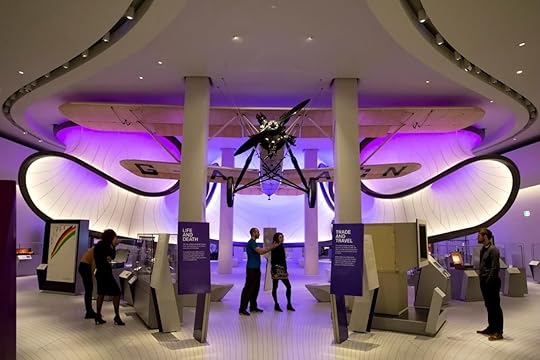
Photo: Science Museum
Just a couple minutes’ walk from the National History Museum is the award-winning Science Museum and the V&A (Victoria and Albert Museum). If you’re into everything and anything to do with science and technology, then head straight over to the brilliant Science Museum. Start off by exploring the ground floor, home to the famous Exploring Space gallery, which features an impressive selection of satellites, probes, and space rockets, including a replica of the Eagle, the lander that took astronauts Armstrong and Aldrin to the Moon in 1969. Then, at 1:00 PM, make your way to the third floor for your 40-minute free guided tour of the Flight Gallery, a hall filled with hot air balloons, gliders, and aircraft, including the Gipsy Moth, which Amy Johnson flew from London to Australia in 1930.

Photo: Victoria and Albert Museum/Facebook
If it’s fashion, textiles, and design that speak to you, then opt for the V&A instead. With over 100 galleries to explore, you’ll need to prioritize. We recommend taking the free “introductory tour” at 12:30 PM, which will give you an overview of some of the museum’s most precious collections, as well as the building’s fascinating history. If you choose to go at it alone, be sure not to miss the Jewellery Gallery (a dazzling collection of over 3,000 necklaces, bracelets, and earrings from the ancient world to the present) and the British Galleries (a lavish display of priceless furniture pieces that showcase the best of British design between the 1500s and 1900s).
Before you leave the West for more museum exploring in Central London, stop by the beautiful Refreshment Rooms inside the V&A, which serve a wonderful selection of tea and coffee, freshly baked cakes, and farm-fresh lunches.
Bonus tip: Like the National History Museum, the V&A and the Science Museum both offer after-hour visits and special events once a month. Check out their schedule here and here. The V&A also stays open later on Fridays.
Afternoon: Trafalgar Square
Whilst you could easily while away the whole day gawking at T-rex and priceless jewelry pieces in South Kensington, if you want to get in as many museums as possible in one day then you’ll need to jump on the central line to Trafalgar Square. Here, as well as iconic monuments like Nelson’s Column and St. Martin in the Fields, you’ll find another cluster of London’s best-known museums: the National Gallery, National Portrait Gallery, and London Transport Museum.
2:00 PM: National Gallery (free)

Photo: National Gallery/Facebook
Arrive at the National Gallery — a stunning 1800s building home to over 2,000 masterpieces from the likes of Leonardo da Vinci, Claude Monet, and Vincent van Gogh — just in time for the one-hour guided tour at 2:00 PM (Monday-Friday only). Guided by volunteer historians and art aficionados, this free tour will give you a great overview of some of the gallery’s most important works. If you prefer to explore solo, don’t miss the Eastern Rooms where works by world-famous British artists John Constable and JMW Turner, as well as masterpieces by other Impressionists such as Monet and Renoir, are displayed.
3:30 PM: National Portrait Gallery (free) or London Transport Museum ($21.61 online, $23.58 at the door)

Photo: National Portrait Gallery/Facebook
Right next door to the National Gallery is the National Portrait Gallery, so it would be rude to miss it. With 215,000 paintings, this grandiose museum is home to the biggest collection of portraits (think royals, politicians, scientists and even modern-day celebrities) in the world. Start your self-guided tour (audio guides for $3.93 are available at reception) on the first floor, where you’ll be able to trace the fall of the British Empire through vivid portraits and lavish statues of Queen Victoria. Then, head straight to the fourth floor for a peek at “Chando’s portrait” (thought to be William Shakespeare, this is the first portrait that the gallery acquired in 1856). If you feel like splashing out a little, stick around for dinner with a view over Trafalgar Square and the Houses of Parliament at the beautiful Portrait Restaurant.
Bonus tip: If you’re here on a Friday, you’re in luck: Both the National Gallery and National Portrait Gallery are open until 9:00 PM (instead of 6:00 PM), meaning you can take this part of the itinerary a little slower if you wish.
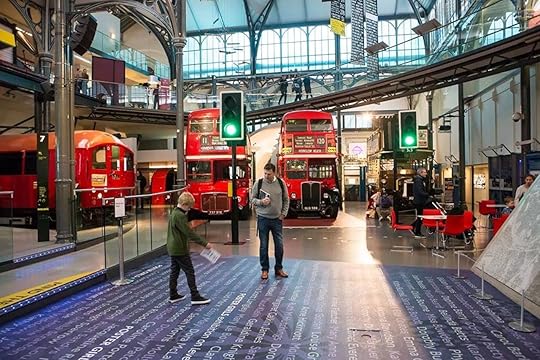
Photo: London Transport Museum/Facebook
If a double whammy of period paintings sounds like a little much, then opt for the nearby London Transport Museum instead, where horse-drawn buses and vintage tube trains — as well as hundreds of old maps, transport signs, uniforms, posters, and photographs — give an insight into how transport made London into the great city that it is today. Once you’re done clambering through old tube, bus, and train carriages for an hour and a half, finish off the day by hunting down some cool souvenirs in the museum’s gift shop on the ground floor, where you’ll get your hands on vintage underground posters, tube-themed canvas bags, and iconic signs to hang up on your walls at home. 

More like this: How to crush the Louvre in one day
The post The ultimate rainy day tour of London’s museums appeared first on Matador Network.

How to do the El Paso Mission Trail

Covering a nine-mile stretch of faith along the El Camino Real de Tierra Adentro, twisting through south Texas outside of El Paso, is the “Royal Road of the Interior.” This is the oldest — and once the longest — road in North America, running from Mexico City to Santa Fe. It contains three historic churches, which uniquely blend Mexican, Spanish, and Native American culture into centuries of spiritual and historic traditions along the Rio Grande River.
The stretch is known as the El Paso Mission Trail, and it takes you on a journey through faith on the frontier dating back to the late 1600s when Spanish explorers and missionaries traveled north from Mexico. In 1680, the Pueblo Revolt forced almost 2,000 Spaniards along with hundreds of Tigua and Piro Indians to flee northern New Mexico using the El Camino Real to El Paso del Norte. Along the way, three churches were built, among the oldest parishes in Texas and known as the trail’s three missions. You can enter each of the historic adobe churches for the ultimate crash course in Southwest history. Here’s how to make the trip.
Start in the oldest town in Texas.
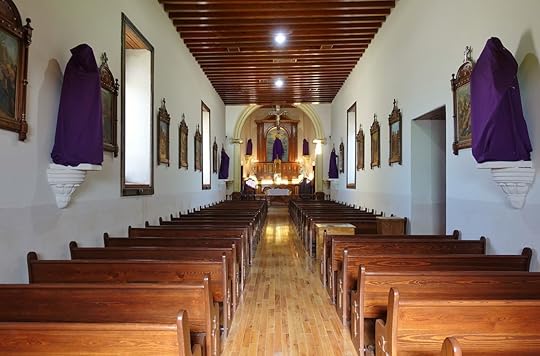
Photo: EQRoy/Shutterstock
The El Paso Mission Trail is about 20 minutes southeast of downtown El Paso. Join in Ysleta, the oldest town in Texas and home to the original mission. The first mass was held here on October 12, 1680, in the original church of the first mission, likely made of mud-chinked logs and willow reeds. Meaning “little island,” Ysleta was named after the original Tigua Pueblo of La Isleta in New Mexico, and the Native American influence in this mission is from the Tiguas.
They founded the Ysleta del Sur Indian Pueblo in 1682, with its cornerstone being a more permanent Ysleta Mission built of adobe, though it was destroyed by a flood in 1740. After the 1829 flood destroyed the second building, it took until 1851 for the building that is the present-day Ysleta Mission to reopen. In 1907, most of the church was destroyed once again, by fire this time, and rebuilt around the unscathed sacristy and what remained of the adobe walls. Before you enter the church, check out the grounds and the building’s exterior.
The mission tends to feel like the hub of town — the bus station and visitors center are catty-corner to the facility, and the Speaking Rock Entertainment Center shares a parking lot with the church. Step back from the church’s door to see the statue of San Antonio de Padua, patron saint of the Tiguas in the gable. Just to the right is the silvery-white bell tower dome, which almost glitters in the sunlight.
The inside of the church is surprisingly simple, with wooden beams across the ceiling, wood pews, and floor. There are a few plain windows allowing for natural light to stream in. You can almost feel the history as you walk through the narthex — the Stations of the Cross are depicted in paintings housed in simple wood frames, and the ornate Our Lady of Guadalupe shrine is tucked away on the right.
The altar nave has gold accented wood, a painted ceiling and a dramatic crucifixion at the top of the nave. As you approach the altar, two other statues come into view along with two simple stained glass round windows — to the right of the altar is Our Lady of Mount Carmel, and on the left is Saint Kateri Tekakwitha, the first Native American recognized as a saint by the Catholic Church. Just below her is a fairly graphic Santo Entierro (Christ in the Coffin), so be prepared to feel a bit of shock. On the feet is a date stamp of 1722. It is believed to have been brought from Mexico and ferried across the Rio Grande before arriving here in Ysleta.
Socorro Mission is the second oldest — by one day.
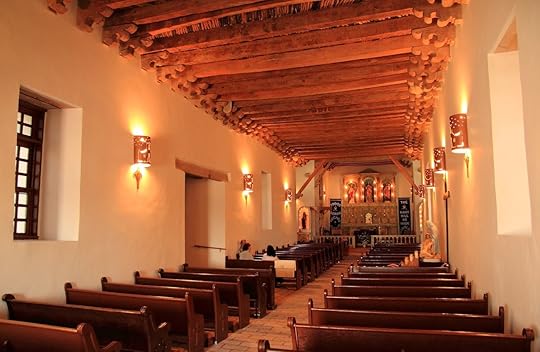
Photo: William Silver/Shutterstock
Once you’ve walked through the Ysleta Mission, drive the three miles up Socorro Road to Socorro Mission. This church seems larger, in part because it is surrounded by open space. Socorro means “help.” Like the Tiguas, the Piro Indians fled New Mexico because of the Pueblo Revolt of 1680. According to records, Fray Antonio Guerra delivered the first mass on October 13, 1680, one day after the first mass in Ysleta. Like Yselta, the first two buildings were destroyed in the floods of 1740 and 1829. The building you see today was completed in 1843 though it fell into disarray over the ensuing 150 years. It took a 10-year, community-based collaboration to restore the mission, which reopened in 2005.
The inside is simpler than Ysleta with only two lines of wooden pews. Along the two long adobe walls of the church are four-paned windows and simple wooden crosses illuminated by sconces for the Stations of the Cross. Of the three churches on the El Paso Mission Trail, Socorro has the least ornate nave, allowing the vividly colored altar to stand as the focal point. Be sure to look up at the intricate design of the ceiling as you walk through — the carved cottonwood and cypress beams, called vigas, have designs painted on them dating back to 1691. They were actually salvaged from Socorro’s first mission after the flood waters receded, making them among the most historic artifacts in any of the three churches. It is believed the Piro people painted the beams with plant-based pigments and the diamond represents the four directions, with the circle as the sun.
There are a few other sites worth a quick stop within the first mile of the six-mile trek to San Elizario from Socorro Mission. Tienda de Carbajal was part of a walled hacienda dating back to 1852. Look for the building with Sombras del Pasado, now closed, painted on the side. Casa Ortiz was built in the late 1700s by Father Ramon Ortiz. The hacienda’s thick adobe walls with cottonwood and willow vigas make it an excellent example of Spanish colonial frontier architecture.
The Chapel (that wasn’t) and the Presidio
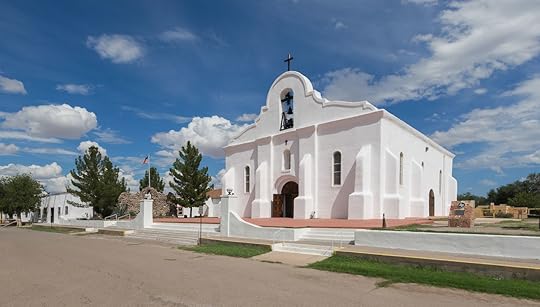
Photo: Nagel Photography/Shutterstock
The architecture of San Elizario Chapel, the final mission on the trail, differs starkly from the other two churches. It was built in 1789 and never actually intended to be a mission. Instead, this was originally the fort chapel and blends the Euro-style architecture of arches and columns with the white adobe box-like structures common in West Texas and New Mexico. The Presidio was named after San Elceario, the French patron saint of soldiers, and eventually became known as San Elizario. Like the other two churches, the original chapel was destroyed in the flood of 1829. The present-day chapel was completed in 1882, and of the three missions you’ll visit, this is the only one with a plaza.
As you walk inside, you’ll immediately notice that it is much larger than the other two and has beautiful stained-glass windows. Damaged by a fire in 1935, a turquoise and gold pressed-tine ceiling covers the original ceiling beams, and decorative posts now encapsulate the original plain wood columns. The Stations of the Cross are more ornate here than at the other two churches and date back to around 1918. After exploring the chapel, relax in the shade of the trees lining the plaza and then explore the Presidio. The streets are designed in a formal rectangular grid pattern common in Spanish colonial town planning. There are 17 sites with markers, so you can learn more about each building.
The San Elizario Historic District is the site where the first horses entered the American Southwest. It’s also the oldest Main Street in the United States, a rest area for the Butterfield Stagecoach Route and the site of the Salt War riot of 1877, dubbed the biggest gunfight of the Old West. San Elizario stakes claim to have celebrated the first Thanksgiving in the United States when Don Juan de Oñate asked friars to say a Mass of Thanksgiving as he formally claimed the land for the King of Spain, 23 years before the pilgrims set sail from England.
Experience more of the region’s past through its galleries, museums, and cuisine.
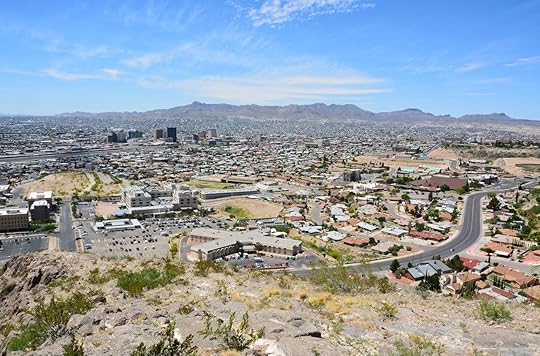
Photo: Alizada Studios/Shutterstock
As you walk around San Elizario Presidio, dip in and out of the many galleries located within two of the historic buildings. For religious relics, shop in the gift shops of Ysleta and Socorro Missions. Your first port of call beyond the missions themselves should be Escamilla Fine Art Gallery and Studio, which showcases the artistic work of Alberto Escamilla. There’s a chicken crossing sign by Saldana Gallery and Studio, so watch for chickens as you cross the street towards it. Learn more about the history of San Elizario in the Los Portales Museum. If you’re into western action heroes, stop by the Old El Paso County Jail, dating back to 1821. According to legend, famed outlaw Billy the Kid freed Melquiades Segura from here in 1876, the only man to escape the jail. Coincidentally, this event also marked the only time Billy the Kid broke into a jail.
The region’s Southwest cuisine is on display at Bowie Bakery, in between Socorro Mission and Ysleta Mission. Pick out a cuello (doughnut-shaped pastry), cuerno (croissant), or sweet empanada to satisfy your sweet tooth. There are also options for authentic Mexican food along Socorro, of which a gordita and lemonade from Celia’s is the best for a quick bite, though locals in San Elizario say Sofia’s — on Glorietta Street — has the best tostadas and overstuffed corn gorditas around. Strike up a conversation with other diners and you’re likely to learn even more about the heritage and the history of faith on the frontier along the El Paso Mission Trail. 

More like this: For a mountain vacation where you can actually relax, head to southern New Mexico
The post Faith on the frontier: Exploring the El Paso Mission Trail appeared first on Matador Network.

Traveling and hiking with cats

For outdoorsy people the world over, it’s common — expected, even — that, while out on hikes, you’ll run into fellow hikers bringing their dogs along to enjoy the fresh air and exercise. But increasingly, we are starting to stop people walking with their cats. And pics of these hecking cute “cattos” are taking over social media, as well as hiking trails, urban bike paths, and outdoor spaces everywhere. The furr-enzy is here, and they’re called adventure cats.
These photogenic felines are here for your likes, and they know how to get them. Photos show them posing against incredible natural backdrops — evergreen forests, aquamarine lakes, alpine meadows, snowy mountains — for envy-inducing snaps, edited to professional perfection. Sometimes they’re outfitted in cat-sized raincoats or patterned sweaters. Sometimes they peek out from bulky backpacks or those Space Age carriers with the giant bubble windows. One thing’s for sure, though: Adventure cats are here to take over your feed and your heart.
But what looks simple and straightforward on a carefully curated Instagram account almost never is in real life. And anyone who’s ever tried to train a cat to do something it doesn’t want to do knows that all too well. On the other hand, try stopping a cat from doing something it does want to do.
Curiosity called the cat.
View this post on InstagramA post shared by hi my name is tuna (@tunatheadventurecat) on Mar 7, 2019 at 9:51am PST
Adventure cats come in all different shapes and sizes. There’s Tuna, an Abyssinian-Siamese mix; Leon the orange tabby; and Cash, an emerald-eyed mini black panther with the absolutely perfect Instagram handle of “cashmeowtside.” There’s even Nathan and Winnie, two cats who love to swim and are constantly hitting the beach with their owners. Full breed, mixed, bought from breeders, rescued from shelters: The range of adventure cats runs the gamut of breeds, ages, and temperaments, from precocious kittens to laidback oldies.
View this post on InstagramA post shared by Cash the Adventure Cat (@cashmeowtside) on Mar 31, 2019 at 3:47pm PDT
And just as there’s an adventure cat of every shade, the process of creating one varies too. In the case of Internet darling Suki, she was fated to explore the great outdoors from the very beginning.
View this post on InstagramA post shared by Suki Cat (@sukiicat) on Apr 28, 2019 at 8:57am PDT
Martina Gutfreund and her partner are definite cat people. But with a career requiring a lot of travel around their native Alberta, Canada, when the time came to choose a new member of their tribe who could join them on the road, they wanted a cat with a predisposition for adventure — a high-energy breed. After doing some research, they brought home a fluffy kitten from a local breeder and named her Suki.
Suki the kitten grew into Suki the Adventure Cat, a sleek Bengal with piercing blue eyes who has racked up 1.4 million followers on Instagram with snaps of her adventures, traversing the mountains and lakes of Canada and even journeying as far afield as Europe. Commenters gush and coo over her immaculate pics. She’s gotten so popular that she even has her own merchandise line, with shirts, mugs, phone cases, and temporary tattoos.
“She loves going outside,” Gutfreund says. “She paws at the door whenever she’s ready to go for a hike!”
With her own personal Instagram following of more than 500,000, Gutfreund was already a savvy photographer and Instagrammer, making it easy to parlay those skills into making Suki a star. Suki’s playful attitude and striking stare are the perfect complements to Gutfreund’s landscape photography, and the two together are a match made in heaven.
Living just a short drive from “absolutely incredible trails” in the nearby Rocky mountains, Gutfreund says that Suki isn’t the only leashed feline hitting the trails. “There’s a huge hiking culture here… and it’s easy to drive to the mountains with your pet.” She also says that, compared to the US, Canada has more lenient rules for permitting cats and other pets into national parks, which could partly explain its regional popularity.
View this post on InstagramA post shared by Suki Cat (@sukiicat) on Mar 27, 2019 at 9:17am PDT
But even in choosing a more high-energy breed, Gutfreund and her partner still have to be patient taking Suki on her hikes.
“We take it pretty slow. We choose short hikes… but it takes four to fives times longer than a normal hike would,” she laughs, saying that they need to go slow in order for Suki to literally stop and smell the roses. “And if it’s not a harder hike, she won’t want to do it.”
Suki is one of the most recognizable and famous examples of the adventure cat trend, and Gutfreund thinks that the proliferation of information about outdoorsy cats on the Internet is part of why the trend has taken off so much.
“It’s so easy [to find information] and I think the more people see these images [of adventure cats], the more they’ll want to try it with their cats.”
The original Adventure Cat
But when and where did the adventure cat craze begin? To answer that question, we go back to 2013, outside a grocery store in Oregon.
Stephen Simmons wasn’t looking for a cat. Living out of a Jeep with his service dog Puppi and spending the majority of his time decamping into the Oregon wilderness, he thought the idea of adding a cat to that equation seemed too much. But when he first held a tiny brown-and-white-bibbed kitten being given away by a homeless woman, there was an instant connection.
“I immediately recognized a wild spirit in him, and knew I was keeping him; he belonged with us,” Simmons says of that fateful encounter. “He belonged in the outdoors.”
View this post on InstagramA post shared by Burma AdventureCat (@burmaadventurecat) on May 1, 2018 at 7:12pm PDT
Now, alongside Simmons and Puppi, Burma has conquered mountains, forests, deserts, and the Internet on his “Burma AdventureCat” Instagram account, started shortly after Burma came into Simmons’ life and which currently has more than 73,000 followers keeping track of his every furry step.
“I started calling him adventure cat. That’s one of his nicknames. So when I hashtagged #adventurecat I was actually just tagging his name and our account,” Simmons explains. “A year or so later it had started catching on as a regular hashtag… and it’s done well and branched out since.”
Ain’t no scaredy-cat
View this post on InstagramA post shared by hi my name is tuna (@tunatheadventurecat) on Feb 17, 2019 at 9:34am PST
But like anything that goes viral, adventure cats and their owners have their fair share of naysayers, with Internet commenters expressing concern about whether the cats actually enjoy their outdoor activities, if the owners just doing it for the ‘gram, and if the cats are truly safe.
“Without a doubt, there are probably some people who take their cats places for the not so right reasons, but that’s a minority,” Simmons says.
Gutfreund, Simmons, and other adventure cat owners are adamant that the cats enjoy themselves and that they as owners do everything in their power to support and protect the cat. And seeing pictures of Burma trekking through the snow to the top of mountains and then glancing back at the camera as if to say “I’m bored, what else you got?” or Suki blissfully closing her eyes while canoeing with Gutfreund, it’s not hard to imagine that the cats are genuinely having the time of their lives.
“I think it’s totally unfair to say that cats are too scared to go on adventures or go outside,” says Gutfreund. “It’s all about acclimation.”
Even many veterinary professionals are in support of cats getting outdoors more (albeit in a safe, controlled manner).
“Truthfully, I love it, but with certain caveats,” says Dr. Christopher Pachel. A veterinarian, feline behaviorist, and owner of the Animal Behavior Clinic in Portland, Oregon, Dr. Pachel is enthusiastic about the growth of adventure cat culture but urges owners to do proper research and take their time during training so that the “enjoyment and comfort of the cat” is always prioritized.
He also raises the important issue that allowing cats to be outdoors under controlled circumstances can be better for local wildlife. A 2013 study by the Smithsonian Conservation Biology Institute and the US Fish and Wildlife Service showed that domestic cats kill billions of birds and mammals a year. Keep a cat on a leash, and they can still explore and get fresh air without harming wildlife.
“Cats contribute to killing a lot of native wildlife in the areas where they’re let out,” Gutfreund agrees. “I think it’s responsible to have your cat on a leash and still have them enjoy the outdoors on a regular basis.”
Could my cat be an adventure cat?
View this post on InstagramA post shared by Leon the Adventure Cat (@leonadventurecat) on May 6, 2019 at 10:36pm PDT
The short answer is maybe. Not every cat will react well to a harness or leash; some cats might be too scared of going outside. But if it’s something an owner is curious to explore, going at the cat’s pace is paramount.
“You have to read your cat’s body language,” explains Gutfreund, who started training Suki within the first few months. “I’d definitely recommend start training them young. But I do think… any cat could be an adventure cat, it’s just how you raise them.”
“Know and understand cats, as the creatures they are,” adds Simmons, who didn’t do any specific training with Burma and instead says that most of the learning and adjustment process was more on his end. “Know your cat, as the individual they are, and always put their safety and their enjoyment first, and have realistic expectations.”
And Dr. Pachel is right there with them, saying, “Slow and steady. Don’t set a strict timeline, it should be based on what your cat needs.”
“It takes the whole point out of it if your cat isn’t actually enjoying themselves,” Gutfreund agrees.
Although the training process depends on the cat, some patterns emerge that appear to work best: First, introduce the cat to the gear by association before trying to put it on them. Take everything one step at a time and don’t set rigid expectations. When first going outside, only do so for a few minutes at a time. Make sure they’re always leashed. Constantly be aware of the surroundings and keep an eye out for potential threats that could spook or harm the cat. Make sure the cat is up to date on its shots. And, of course, use lots of treats for positive reinforcement.
But also, be prepared to accept it and let the idea go if the cat doesn’t adjust or isn’t happy.
The future is feline.
View this post on InstagramA post shared by Nathan & Winnie the Beach Cats (@nathan_thebeachcat) on Jan 20, 2019 at 12:26pm PST
Most Internet and Instagram trends have a shelf-life. So what’s next for adventure cats?
“Personally, I believe the adventure cat trend will only increase,” says Simmons, adding that he feels “humbled” that he and Burma helped create this movement. “I believe it’s in all cats’ nature to enjoy the outdoors… and [owners] are enjoying the realization… that their more active lifestyle can actually accommodate a cat.”
Dr. Pachel is also optimistic about where adventure cats and their owners are headed next. “It’s helping pet owners get a glimpse of what’s possible and think outside the box. It allows cats to experience the world around them.”
Looks like the cat is out of the bag — and hitting the trails, for good. 

More like this: This luxe Santa Monica hotel will send gourmet room service to your dog
The post Adventure cats are taking over Instagram and coming for travel dogs’ reign appeared first on Matador Network.

Man returns stone from Stonehenge
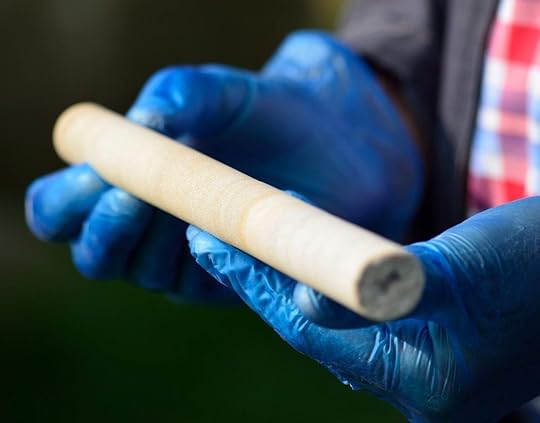
This piece of Stonehenge certainly was the ultimate souvenir, though taking it wasn’t exactly ethical. Fortunately, it’s now back where it belongs — in Wiltshire.
The approximately three-foot-long stone core was removed in 1958 during archeological excavation at the site and was kept by one of the employees on the project, Robert Phillips, for 60 years.
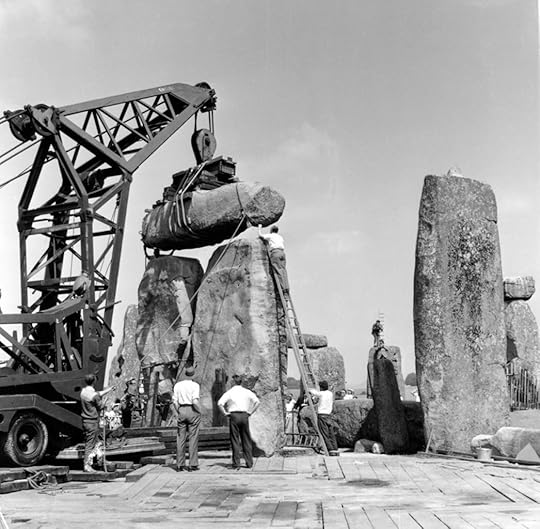
Photo: English Heritage/Facebook

Photo: English Heritage/Facebook
After keeping it in his office for years and taking it across the pond to the US where he later immigrated, Phillips, 90 years old, has decided to have the sample of one of the enormous sarsen stones returned to its rightful place, so his sons traveled to the UK and brought it back in pristine condition.
Heather Sebire, English Heritage’s curator for Stonehenge, said in a statement, “The last thing we ever expected was to get a call from someone in America telling us they had a piece of Stonehenge. We are very grateful to the Phillips family for bringing this intriguing piece of Stonehenge back home. Studying the Stonehenge core’s ‘DNA’ could tell us more about where those enormous sarsen stones originated.”
Phillips’ gesture may help solve one of the mysteries surrounding the 5,000-year-old site.
English Heritage is also currently searching for two other cores that have been taken from the site. Perhaps Phillips’ gesture will inspire others to come forward and bring back the missing pieces of the prehistoric site. 
H/T: Business Insider

More like this: 7 ancient ruins in the UK beyond Stonehenge
The post Man returns ‘souvenir’ chunk of Stonehenge after 60 years appeared first on Matador Network.

Why you should visit Milan even if you aren’t into fashion
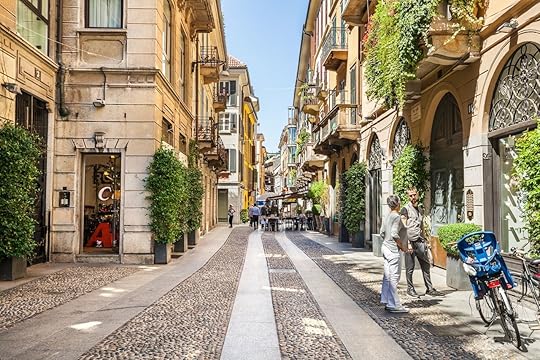
Milan is synonymous with Italian fashion and design. Its Fashion Week is on any style aficionado’s calendar, its Galleria Vittorio Emanuele II is the oldest shopping arcade in Italy, and its designer shops are revered as historic monuments. But Milan offers far more than spending opportunities. It’s home to one of the most iconic artworks in the world, its signature dish is flavored with gold, and its bars hark back to the glamorous 1940s. Here are nine reasons to visit Milan if your budget doesn’t stretch to souvenirs from the original Prada store.
You won’t wait in line at the Pinacoteca di Brera.

Photo: KrimKate/Shutterstock
Anyone who has waited in the queue for the Uffizi gallery in Florence will know the price you have to pay to see great art. But in Milan, you can sail straight into the Pinacoteca di Brera and see a magnificent collection without the wait. This gallery houses the extraordinary Lamentation of Christ by Andrea Mantegna, famous for the positioning Christ lying flat, feet facing the viewer and body dramatically foreshortened. You can also see the popular Francesco Hayez painting The Kiss, both from inside the gallery room itself and while seated at the bar in the Brera’s new Caffé Fernanda. Make sure you finish your visit with an espresso in this retro bar with a distinctly ‘50s Italian aesthetic.
Milan has one of the most famous artworks in the world.

Photo: posztos/Shutterstock
The Louvre may have Leonardo’s Mona Lisa, but Milan has his Last Supper. This iconic fresco by the Renaissance master is housed in the Refectory of the Convent of Santa Maria delle Grazie. The fresco depicts the moment Christ tells the Apostles that one of them will betray him and the emotional reactions of each. Despite the fresco’s deterioration and heavy restorations obscuring much of the hand of the original artist, Leonardo’s depictions of human emotions and the layers of meaning he embedded in the artwork can still be appreciated. Remember to book well in advance as only 30 people are allowed in at a time.
The signature dish is made with gold.

Photo: marco maye/Shutterstock
One of Milan’s traditional dishes is saffron risotto, whose origins actually lie in the saffron rice that the Arabs brought to Sicily. Trattoria Masuelli San Marco, established in 1921, is one of the few restaurants in Milan that still uses the traditional recipe, which involves a broth made from five different kinds of meat. But if you want a richer version of the dish, in a very literal sense, head to the Marchesino restaurant where chef Gualtiero Marchesi adds a layer of gold leaf to his risotto.
The espresso comes with ginseng.

Photo: tarapong srichaiyos/Shutterstock
Despite cappuccino, macchiato, and espresso all now being familiar to English ears, the caffè al ginseng has not yet achieved fame in English coffee culture. Caffè al ginseng is coffee flavored with ginseng root extract, giving in a sweet, aromatic taste. It is now popular throughout Italy, but it was Milan that introduced this Southeast Asian concoction to the Italian coffee scene. If you’re arriving in Milan by train, fortify yourself with un ginseng at Bistrot Centrale in the station, along with the high-flying Milanesi heading off to work.
Tiny aperitivos have given way to hearty apericenas.
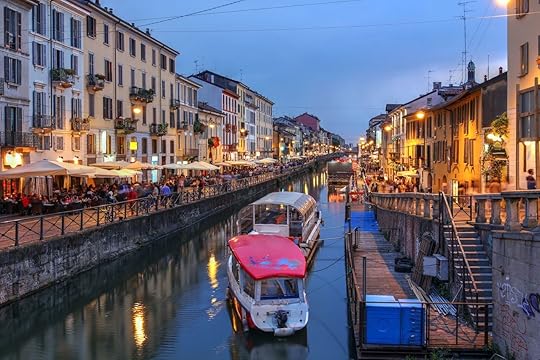
Photo: Mihai-Bogdan Lazar/Shutterstock
Aperitivo is old news in Milan. Instead, the city offers the bigger and better apericena, a word which combines aperitivo with cena, meaning dinner. While an aperitivo provides drinkers with nibbles like crisps, olives, and mini sandwiches, the apericena is a full-blown buffet often including hot meat dishes, pasta, and cooked vegetables. Milan’s Navigli, part of a system of canals, is the most popular place for pre-dinner drinks in the city. Artsy bars with outdoor seating line the canals, and most offer an apericena deal of food and one drink for around $11.
You can time travel in Milan’s design bars.

Photo: Ceresio 7 Pools & Restaurant/Facebook
Milan’s accolade as “fashion capital” extends to more than just clothes. The city is home to several design bars that evoke iconic historical periods of Italian design with their decoration. Bar Luce, located inside the Fondazione Prada, was designed by Wes Anderson. Its retro style channels the ‘50s with Formica furniture, industrial style lighting and fittings, and a typically Anderson palette of beige and teal. Rooftop bar Ceserio 7, instead, harks back to the rationalist era with its clean, geometric aesthetic and turquoise leather sun-loungers around the outdoor pool.
The cathedral took six centuries to build.

Photo: MarinaD_37/Shutterstock
Milan’s Duomo is a symbol of the city, not only because of the beauty of the architecture but also because it is such a contrast to the fabric of the city around it. It is built from Candoglia marble, rather than the traditional Lombard brick, giving it a luminosity compared to the surrounding piazza. Moreover, the Gothic style that was at the height of fashion when building began in 1386 is in sharp contrast to Milan’s modernity. But despite the Gothic appearance, it took six centuries for the building to be completed, so there are Renaissance and Baroque elements in the interior, and the much-loved golden statue of the Madonna on the roof, called the Madonnina, dates from the 18th century.
It has world-class opera at La Scala.

Photo: Kiev.Victor/Shutterstock
Milan’s Teatro all Scala has been at the cultural center of the city since the 18th century. This opera house has hosted Mozart performing some of his early works, and great Italian composers like Giuseppe Verdi and Giacomo Puccini. But it is also at the social heart of the city, and, after bombing during the Second World War, it was one of the first buildings to be reconstructed. The ornate, gilded tiers of the auditorium are the place to rub shoulders with Milan’s cultural and social milieu as you watch world-class performances that are often broadcast around the globe.
You can practice the art of window shopping.

Photo: Olgysha/Shutterstock
Even if you’re not visiting Milan for the shopping opportunities, you shouldn’t dismiss its fashion culture completely. The Galleria Vittorio Emanuele II is as much a cathedral as the Duomo next door, only here it’s commerce that’s worshipped. It houses the original Prada store and historic bars like Camparino. Via della Spiga is also famous for haute couture fashion, and the window displays of the stores are works of art in themselves. Dolce & Gabbana has particularly engaging and quirky displays. While you might need a bank loan to be allowed into the stores, it’s worth reserving time for window shopping in Milan. 

More like this: Naples may be rough around the edges, but here’s why we love it anyway
The post Why you should visit Milan even if you aren’t into fashion appeared first on Matador Network.

4,500-year-old cemetery discovered by the Pyramids of Giza

While it’s not exactly a surprise that Egypt is full of archeological wonders, it’s still staggering to hear that discoveries are being made, especially in some of the country’s most-heavily visited sites.

Photo: Ministry of Antiquities وزارة الآثار/Facebook
The Egyptian Ministry of Antiquities announced on May 4 that several tombs and burial shafts from the Old Kingdom — the oldest tomb dates back to 2500 BC — have been uncovered during excavations on the Giza Plateau. The tombs contain the remains of workers who built the pyramids, as well as other individuals.

Photo: Ministry of Antiquities وزارة الآثار/Facebook
The oldest of the tombs belonged to a family and contains the intact sarcophagi and remains of two people from the Fifth Dynasty, named “Behnui-Ka” and ”Nwi Who.” Both individuals held several seemingly powerful titles, such as “purifier” and “judge” as the hieroglyphic inscriptions found revealed.

Photo: Ministry of Antiquities وزارة الآثار/Shutterstock
According to Archeology.org, artifacts were also found at the burial site, including a limestone statue depicting one of the two men with his wife and son, painted wooden coffins, and wooden and clay funerary masks dating to the eighth century BC from when the cemetery was reused. 
H/T: Lonely Planet

More like this: 7 underrated sites in Egypt worth visiting, according to an archaeologist
The post 4,500-year-old cemetery discovered by the Pyramids of Giza appeared first on Matador Network.

Air New Zealand passenger removed

Many airplane passengers are guilty of not paying too much attention to the safety video, card, and demonstration on airplanes before takeoff — an act of obliviousness that apparently can cost you big.
A woman sitting in an exit row on an Air New Zealand flight from Wellington actively refused to watch the safety video, or read the instructional card, and was consequently removed from her flight.
Understanding safety instructions is always important, especially when you’re seated in an exit row since you are responsible for the lives of other passengers in the case of an emergency.
Described by other passengers as “wealthy-looking,” the woman ignored flight attendants’ many requests to listen to safety instructions.
According to one passenger, “The video started playing and the flight attendant held up the card, but the woman started looking down at her book. A flight attendant said very patiently, ‘Can you please watch what’s happening because this is the exit row.’ The flight attendant was super kind and kept asking her, but the woman put fingers in her ears.”
Despite the fact that the woman’s behavior was delaying the plane’s departure, and that other passengers asked her to pay attention, she blatantly ignored the requests. The pilot was eventually forced to return to the gate, where police removed the woman from the aircraft. 
H/T: The Guardian

More like this: 7 rights all air passengers have and should know about
The post Woman removed from plane for refusing to watch safety video appeared first on Matador Network.

Iceland beluga whale sanctuary

Iceland is set to open the world’s first open-sea beluga whale sanctuary this month in the secluded Klettsvik Bay. The inaugural residents will be Little Gray and Little White, 12-year-old female belugas who were taken into captivity as babies from Russia to perform at Shanghai’s Changfeng Ocean World. The whales will make the 6,000-mile journey from China to Iceland via plane, ferry, and truck this spring.
The sanctuary is a bay of 344,455 square feet at Heimaey Island, located off the coast of southern Iceland. The location was chosen as it resembles the cetacean’s natural subarctic habitat and protected from the elements.
Although the bay will be enclosed (it is only partially naturally enclosed), it will provide a more natural environment and more space for the whales who have only lived in small pools or tanks since their capture. Although it would be ideal, it’s impossible to release the two whales in the wild as they would likely not survive.
Visitors will be able to take a 30-minute boat trip to the bay to see the animals from a distance, from August 1 to October 30.
Not everyone is pro-sanctuary, however. Julie Lasserre, marine biologist and vice president of Sea Shepherd Iceland, told Grapevine, “We are grateful that the Sea Life Trust offers to give better life conditions to those two belugas than the ones they had in their aquarium in China, [but] we are afraid that they are going from a captive life to another captive life with a lot of stress in addition.”
Others have questioned whether Iceland is the best location for the sanctuary, as the country allows whale hunting.
The sanctuary hopes that the project will encourage the release of captive marine animals into open sea sanctuaries and put an end to entertainment shows. 

More like this: Beluga whale returns phone woman dropped into the sea
The post Iceland to open the world’s first open-sea beluga whale sanctuary appeared first on Matador Network.

May 7, 2019
Reasons to visit Tbilisi, Georgia

Tbilisi is the colorful capital of Georgia, a country at the crossroads of Europe and Asia. After facing many invasions, from the Ottoman Empire to Russia, Georgia finally gained its independence in 1991 with the breakup of the Soviet Union. Its tumultuous history and mix of cultures make Tbilisi an eclectic, multicultural, and modern city. Unknown to many travelers, it’s slowly becoming a hot destination, so it’s only a matter of time before the crowds descend like they once did on Croatia, and it starts becoming more expensive. Here’s everything you can experience in Tbilisi, and why you should get there before the rest of the world starts swarming in.
Your money goes a long way.
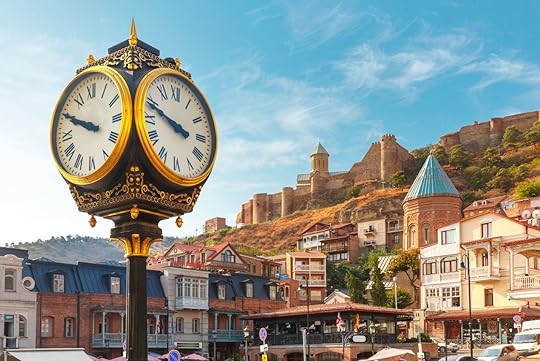
Photo: kavalenkava/Shutterstock
Tbilisi is packed with things to do. On a warm evening, you can stroll in Rike Park along the Mtkvari River and watch kids play in the grass. From the park, you can take a cable car to Narikala Fortress for a sweeping view of the city. Or you can wander around in the streets of Old Town, go to the market, and eat all the food you can.
You can really explore every corner of Tbilisi and not break the bank. Food is very inexpensive, and you can find good private accommodations for a few dollars a night. Traveling by taxi is common and cheap. If you want to go even cheaper, you can take a bus in town for about or $0.20.
The architecture is quirky and awesome.
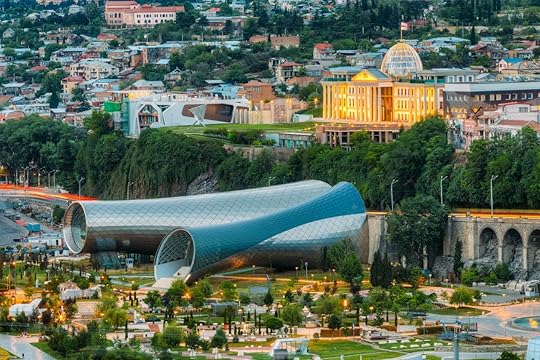
Photo: Grisha Bruev/Shutterstock
Tbilisi is one of the most interesting capitals to visit. Influences from Europe, Persia, the Arab world, and Russia have shaped Georgia’s identity, resulting in one of the most unique cultures in the world. This is visibly reflected in the architecture.
The capital is home to contrasting styles of architecture, from the old bricks in the Old Town to the futuristic Rike Park Concert Hall and the Bridge of Peace. Many of the churches are related to Armenian and Byzantine architecture, while others breathe a more modern vibe. This combination of the future and the past will definitely leave an impression.
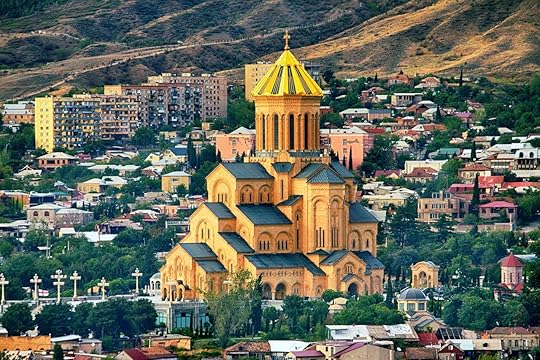
Photo: vvvita/Shutterstock
The Holy Trinity Cathedral is the main cathedral of the Georgian Orthodox Church and is one of Tbilisi’s eye catchers. This massive work of art impresses with its golden dome and arches, and it will make you feel very small. The Cathedral was built between 1995 and 2004 and is one of the largest religious buildings in the world. You’re allowed to enter the church and have a look around. I entered the domain in the evening and was mesmerized by this huge, golden building in front of me. Visit during or after sunset, so the lights are switched on, adding to the magical vibe of this place.
A Ferris wheel looks over the city.

Photo: Alex75/Shutterstock
High above the city towers Mtatsminda Park, a big amusement park at the top of Mount Mtatsminda, which reaches over 2,500 high and is the highest point in the city. Mtatsminda was a very popular public park in the USSR during the Soviet Union.
Although the heydays are over, it is still fun to visit, especially if you’re traveling with kids. There’s a lot to discover in the expansive park, which covers hundreds of acres. There’s a Ferris wheel, bumper cars, a mini-train, a shooting gallery, and lots of food and drink. The old-school, carnival-style attractions from a past era keep the Soviet vibe alive.
Entering the park is free. You just pay per attraction, costing you only a few dollars. Many of the rides are switched off during low season, but it’s still an experience to visit the park. Get up there by bus or take the popular funicular. Besides the fun of old-fashioned rides, you’ll get a panoramic vista over central Tbilisi.
The people are welcoming.
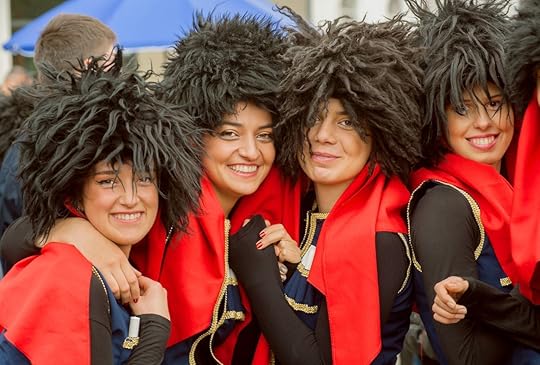
Photo: Radiokafka/Shutterstock
Georgians are some of the warmest and most welcoming people in all of Europe. Although many of them don’t understand or speak English, they’ll go out of their way to help you out. Google Translate often comes in handy here. Homestays are the best way to connect with locals. We usually stayed one to three days in a homestay. You can easily book these online at a very low price. Don’t expect luxury. Homestays are usually quite basic, and the perfect way to get a feel for the culture.
I got my first manicure in Tbilisi, and besides the low price of $4.00, I was touched by the friendliness of the staff. The owner was excited to practice her English with me and opened up about her life and travels. At the end of my manicure, she even went to the shop next door to buy me a present, an owl-shaped piggy bank. These are the type of interactions you can expect in Tbilisi.
Another way to meet locals is to go to one of the many bars in the cozy Shardeni Street and have a chat with other customers. If you feel like it, you can even share a shisha, the popular water pipe with tobacco and fruity flavors.
They love their chacha…

Photo: Serov Aleksei/Shutterstock
We’re not talking about a rhythmic dance but about homemade — very strong — liquor. Chacha is a kind of brandy with an alcohol percentage of up to 65% if homebrewed, and that’s the way they prefer it.
When you book a bed-and-breakfast homestay with locals, there’s a big chance you’ll get to try their chacha. That happened at all our homestays. My first host was Valeria, an older man with a warm smile who welcomed us for three days in his two-bedroom apartment. He didn’t speak a word of English and repeated the same three words every time he saw us: “Kofe, chai, chacha?” The Georgian people love this local brew and sometimes even serve it at breakfast.
…almost as much as they love their cheese.

Photo: Ateles Films/Shutterstock
Georgian cuisine involves a lot of bread and cheese. If you’re planning on losing weight, Georgia might not be the country for you. Cheese is the main ingredient in many of the Georgian dishes, so you’ll be in a warm, gooey heaven from your first meal in Tbilisi and will likely not arise from your food coma until long after you’ve left.
The two main cheeses are sulguni, a fresh cheese made from cow’s or sheep’s milk and often compared to mozzarella, and imeruli, a soft and squeaky cow’s milk cheese. One of the most authentic dishes made with these cheeses is the khachapuri, which is essentially bread and cheese. They come in almost 20 versions, as they are region specific.
The most famous one is the adjaruli khachapuri where you’re served a large, boat-shaped loaf of bread with melted cheese, butter, and an egg baked into the middle. Mix the cheese, butter, and egg, and soak the pieces of the bread in it. The crunchy, toasted bread and soft cheese go very well together and make it a true feast. As you can imagine, it’s quite heavy but hard to say no to its deliciousness. Bean and potato filled varieties are also an alternative to the classic cheesy version.
Every meal is a feast.

Photo: Patrycja Hruszowiec/Shutterstock
Don’t expect for khachapuri to be the only dish on the table. Most meals in Georgia include more food than can physically fit on the table. A must-try is khinkali, Georgian dumplings. They’re originally from the mountains, but you can get them in many places in town. Khinkali are made with a variety of fillings like beef, pork, or potato-mushroom. Order them boiled or pan-fried.

Photo: White78/Shutterstock
Machakhela is one of the restaurants downtown Tbilisi where you can get delicious khinkali. Although it’s part of a Georgian chain of restaurants, it was recommended to us by locals who love it as much as the tourists. The restaurant downtown is big and often packed with customers. There’s no need to make a reservation since there are three floors. There’s also a nice terrace, but if you’re visiting in summer you might prefer to be inside with the air conditioning.

Photo: Viktory Panchenko/Shutterstock
Another delicacy is nigvziani badrijani, an eggplant roll with walnut paste often garnished with a few pomegranate seeds for a fruity finish. You’ll find this delicious appetizer on almost any menu. Turkish coffee is also a favorite. Watch it being freshly prepared in one of the stalls at the train station or order one while enjoying some shade on a terrace. The best way to enjoy all the Georgian food is to do as the locals do and order many different dishes and share everything.
It’s close to a beautiful wine region.
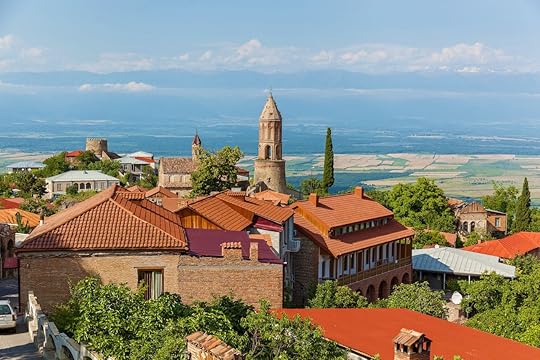
Photo: Photosite/Shutterstock
Only a two-hour drive away from Tbilisi you’ll find Sighnaghi. It’s a picturesque, small town in Kakheti, the wine region of Georgia. Sighnaghi is a cobblestoned village and the perfect place to try some of the famous Georgian qvevri wine. The amber-hued wine uses whole grapes (skin, seeds, stems) and is made underground in clay vessels. This natural method dates back thousands of years. The most famous place to go wine tasting is the Pheasant’s Tear in the center of Sighnaghi, but since it’s very touristy, you’ll pay a lot more than at other wineries.

Photo: Tetiana Dolhachova/Shutterstock
The area around the village is also nice to explore. You can stroll half an hour to the Bodbe Monastery, a beautiful complex of churches run by nuns. It’s surrounded by tall cypress trees and overlooks the Alazani Valley, giving you a view on the mountains. You can walk around beautifully maintained vegetable gardens and enter some churches to admire the frescoes.
You can get to Sighnaghi from the Samgori metro station in Tbilisi. Take a minibus for $2.25. The minibuses aren’t comfortable, but they will get you there. You could also hire a taxi if you are with a few people to share the costs. Like the rest of your stay in Tbilisi, it won’t cost very much and, chances are, your taxi driver will be warm and welcoming. 

More like this: How to plan the ultimate road trip through the Balkans
The post Why you need to see Tbilisi, the capital of Georgia, before everybody else appeared first on Matador Network.

The best things to do in Albania

Although Albania emerged from Communist rule in December 1990, its process of opening up to the world has been slow, and it has been overlooked by even the most adventurous backpackers. Yet, sitting as it does the shores of both the Adriatic and Ionian Seas, between Montenegro and Greece, Albania has a lot to offer. It has stunning, near-empty beaches; ethereal mountains; a rich history. and budget-friendly prices. It’s hard not to be drawn in by this mysterious nation, the homeland of Mother Teresa. One week in Albania is a must for those wishing to explore one of Europe’s lesser-known locations, and here is what to see.
Tirana — pastel colors and a deep history

Photo: RussieseO/Shutterstock
Start your Albanian sojourn in the pastel-colored capital, Tirana. Head to Skanderbeg Square where the great Albanian military leader George Castriot Skanderbeg is immortalized as a statue. Skanderberg is a national hero for the campaign he led against the rule of the Ottoman Empire in the 15th Century.
Next, head across the square to the National Museum of History. Here, you can learn more about Skandenberg, as well as see national artifacts dating back to 2600 BC alongside objects owned by Mother Teresa herself. The 18th-century Et’hem Bey Mosque — a testament to Ottoman rule over Albania until 1912 — sits on the same square. The interior of the mosque is awash in vibrant colors; the ceiling is quite spectacular.
End your afternoon with a meal at Oda, serving classic Albanian fare. The decor is a little eclectic, but the restaurant is considered one of the best in Tirana. Finish your day with a glass of Raki, an anise-infused drink loved in both Albania and Greece.
Caves of Pëllumbas — a deep karst cave system
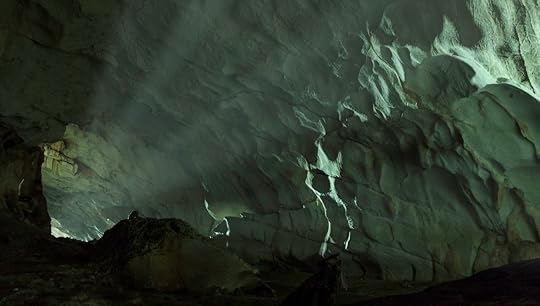
Photo: Edvin Rushitaj/Shutterstock
Take a trip to the karst cave system at Pëllumbas, a 45-minute drive outside of Tirana. Dating back 40,000 years ago, the cave system was once home to an ancient species of cave bear. It was also a settlement during the Middle Paleolithic period. One of only six karst cave systems in Europe, the cave cuts 1,200 feet into the slopes of Dajti Mountain and is also a nesting ground for bats.
You will need to hike to get to Pëllumbas. However, on your way make sure to take in the stunning views surrounding you in this dramatic Balkan landscape. On your way back, finish with a swim in one of the fresh mountain rivers, which meander their way towards Tirana.
Sarandë — the capital of the Albanian Riviera

Photo: Aleksandar Todorovic/Shutterstock
Albania shares the Mediterranean coastline with its southern neighbor Greece. In fact, if you look due east from the coastal region of Sarandë, you would see the Greek island of Corfu. Dubbed the unofficial capital of the Albanian Riviera, Sarandë has become a bustling seaside resort popular with Albanian, Greek, and even Italian tourists.
Although Sarandë takes its name from the Monastery of Forty Saints, dating to 400 AD, which sits behind the town, activities on Sarandë are decidedly more secular. It has beaches and bars aplenty, as well as ample opportunity to take boat trips around this beautiful stretch of shoreline.
Highlights include Mirror Beach, the 16th-century Lëkurësi Castle overlooking the town, and the natural spring Syri Kalter. Syri Kalter, also known as “The Blue Eye” is located 14 miles inland from Sarandë. It’s a stunning natural spring where water bubbles up from a depth of 160 feet. In the evening, take time to relax along the promenade, enjoy Raki cocktails, and watch the sunset over the Ionian Sea.
Butrint — one of the oldest cities in Europe
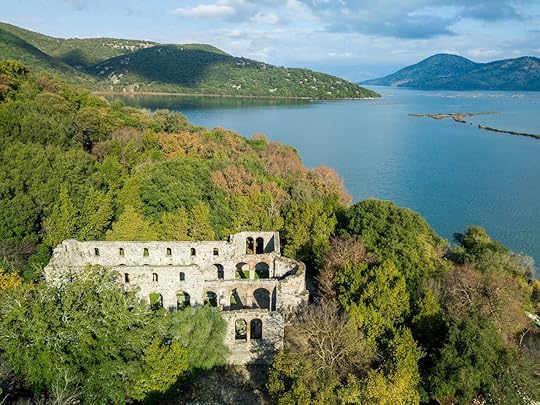
Photo: A Daily Odyssey/Shutterstock
Drive 10 miles south of Sarandë and you’ll find Butrint. The ancient Greek and later Roman city is believed by some to have been founded in 12 BC. With its basilica, acropolis, agora, amphitheater, and baptistry, Butrint earned a UNESCO World Heritage designation in 1992. It became a national park in 2000 and is widely considered one of the most important archaeological sites in Albania. Lying within its own national park, Butrint is an absolute must for anyone in the Southern region of Albania. Day trips are available from Sarandë.
Gjirokastër and Berat — history of empires
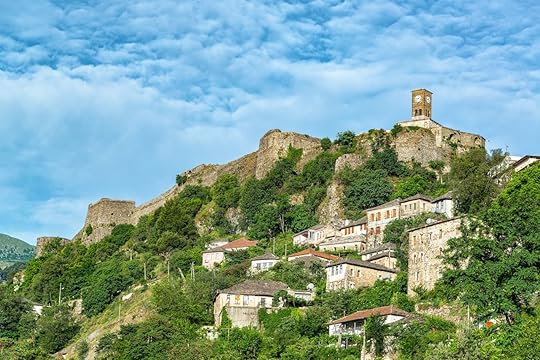
Photo: Jess Kraft/Shutterstock
Gjirokastër was named a UNESCO World Heritage site in 2005, with nearby Berat receiving the honor in 2008. Known as the Historic Centers of Berat and Gjirokastër, the two majority Greek ethnic towns are regarded as two of the best examples of multi-civilizational architecture in Albania. Berat showcases Illyrian, Greek, Roman, Byzantium, and Ottoman architecture and comprises an old fortified city filled with churches and mosques. The town, which became part of the unstable frontier of the Byzantine Empire following the fall of the western Roman Empire, is also known as the City of a Thousand Windows. Highlights include Berat Castle and the medieval Byzantine churches of Holy Trinity and St Michaels.
Gjirokastër, on the other hand, is regarded as one of the finest surviving examples of an Ottoman Town in the world. Highlights include the 18th-century Bazaar Mosque, the Old Quarter, the 12th-century Gjirokastër Fortress, and the childhood home of Enver Hoxha, the infamous Albanian head of state who ruled the country for 41 years. On history alone, Gjirokastër and Berat should be high on anyone’s list of priorities when visiting Albania.
Apollonia — one ancient school of philosophy
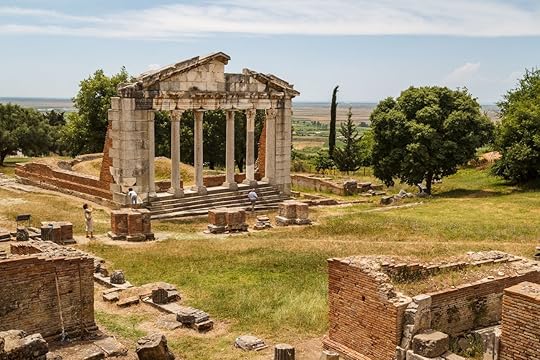
Photo: Lev Levin/Shutterstock
Abandoned by the end of the late Antiquity and later rediscovered in 1915, Apollonia flourished in the Roman period and was home to a renowned school of philosophy but began to decline in the third century AD. A visit to Apollonia is a must, regardless if you’re a veteran Classist or a newbie to Roman history. Highlights include the Monument of Agonothetes and the Church of St. Mary. Visit Apollonia in the evening and watch the sunset upon this ancient wonder as you ponder Apollonia’s fascinating Grecian history. 

More like this: How to plan the ultimate road trip through the Balkans
The post How to spend a mystifying week in Albania appeared first on Matador Network.

Matador Network's Blog
- Matador Network's profile
- 6 followers



